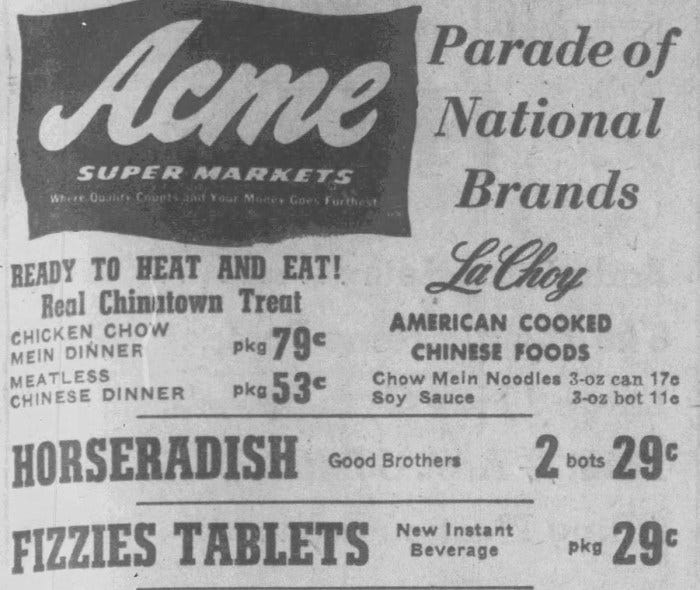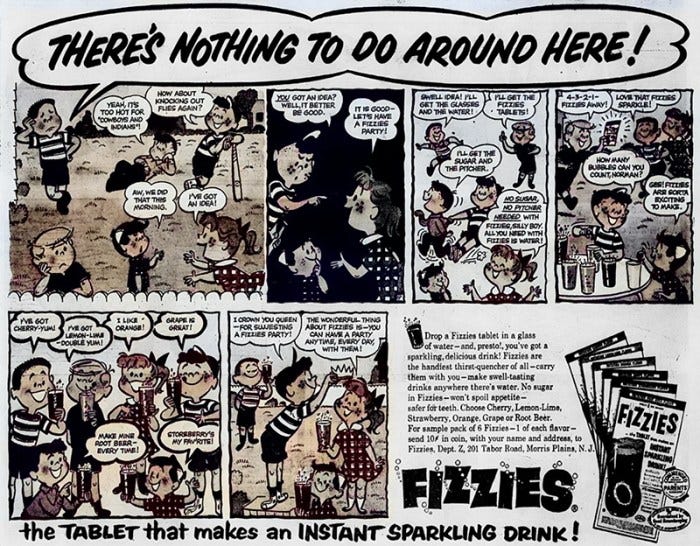Fizzies Drink Tablets
My mother and I would frequently talk about the various foods and treats she had as a kid. Many of them were still available, and I have great memories of us sharing some candy bar or soft drink, as she explained to me when she first had it. Often, though, things from her childhood were not available, and I would have to settle for just the story at the time. One such item were Fizzies.
The History of Fizzies Drink Tablets
You might be familiar with the effervescing medicine Alka-Seltzer. In the United States, it is the dominant fizzing tablet cure, but that was not always the case. In the past, a host of water bubbling cures were available to consumers. One of those was Bromo Seltzer, which was made by the Emerson Drug Company.
Bromo Seltzer was not available as a tablet, so to compete with Alka-Seltzer, they reformulated it in tablet form and sent the resulting product out for testing. While that was happening, the machinery to make the new tablets was just sitting dormant.
At this point, someone had the brilliant idea to add fruit flavor to mask the overwhelming sodium citrate taste of the tablet formulation. I say someone because online sources credit two people with its creation. Traditionally, Lem Billings, who was a vice-president at Emerson at the time, has been given credit for the invention. This is discussed in the book, Jack and Lem: John F. Kennedy and Lem Billings: The Untold Story of an Extraordinary Friendship.
Online, I have seen it repeated that Ruth Millard was behind their creation, but I cannot find a printed or online source outside an uncited addition to Wikipedia that has been repeated. I am including this because it wouldn’t be unusual for someone to come up with the idea, but credit to go to someone higher up in the company.
Regional distribution began in 1956, starting in Pennsylvania. Four flavors were available at the time: orange, cherry, grape, and lemon-lime. They came in packages of eight tablets, would cost you twenty-nine cents.
They were a hit and in locations where it was available, Fizzies captured 45 percent of the non-bottled soft drink market. According to Jack and Lem, as predicted the kids were crazy for the stuff, but it wasn’t the taste that won them over. Instead, it was because, “they could see it sparkle once they dropped the tablets into water. Kids loved watching the bubbling and sizzling.”
Sales were strong, and they would add new flavors like strawberry, root beer, and cola. Then in 1962, Emerson Drug Company was acquired by Warner–Lambert, who decided to take the product nationwide. Turning a regional success into a ten million dollar a year product.
During this period, Fizzies advertising was everywhere. They were even a sponsor of The Shari Lewis Show on NBC in the early sixties. Sadly, not a lot of that show have been posted online. This single complete episode of the show on YouTube shows just how charming the show was and demonstrates why kids would respond to the advertising being run on the show.
While that bit of advertising is currently lost, others survive, like this amazing one from the late fifties. It is a wonderful blend of live-action and animation. So take a trip through a magic mirror to the land of Fizzies and enjoy.
Here you can see one of the typical print ads they ran in the Sixties.
My favorite were these comic style ads from the fifties, that they ran. Like so much advertising aimed at kids, it blurs the lines between advertising and entertainment.
Fizzies were Sugarless
One of the big selling points of Fizzies was that it was a sugarless treat. They initially achieved this sugar-free designation through the use of sucaryl and saccharine. While many people still know saccharine, sucaryl, which was made from cylamate is largely forgotten in the United States.
Cylamate is an artificial sweetener that is 30-50 times sweeter than table sugar. Which makes it one of the less potent artificial sweeteners. When mixed with saccharin, the two balanced out the off-taste components of the other one.
It seemed like a match made in fake sugar heaven, but then in October 1970, safety concerns caused cylamate to be banned in the United States.
This was a major blow to Fizzies, and they scrambled to find a suitable replacement, but came up empty-handed. At this point, they went the Kool-Aid route and instructed consumers to add sugar themselves to the mix. This did not go over well and just a few years into the seventies, Fizzies were discontinued.
For two decades, they would languish in product purgatory. Well-remembered, they were only available in the memories of those who had tried them and in the imaginations, of those to whom they told their story.
Who Needs Water?
A recurring story you will hear from people who got to enjoy Fizzies is that of consuming them without water. Often presented as a fun challenge. Kids, and even adults, would sometimes put a tablet in their mouth and try to keep it in there until it fully dissolved. As a group activity, this could lead to lots of laughs for those watching. Especially when the person couldn’t keep the seething tablet in their mouth, releasing colorful carbonated drool to the delight and disgust of friends and family.
I am happy to report that I did get to try this because Fizzies did finally make a comeback.
The Modern Fizzies Revival
Much to my surprise, in the mid-Nineties, Fizzies made a comeback because of… NutraSweet.
In 1996, the new Fizzies started to be sold across the United States. Sold by Premiere Innovations they came in the following flavors:
Buzz’n Berry
Chug’n Cherry
Groov’n Grape
Ooz’n Orange
Rock’n Rootbeer.
Stories in papers at the time talk about the nostalgia and the reason this soft drink finally returned. According to Premiere Innovations, a group of entrepreneurs who had all grown up with Fizzies bought the rights from Warner Lambert and spent years working to get them back to market.
A package consisted of eight tablets, and depending on where you bought it, would cost you between one and three dollars. Marketing at the time continued to stress that it was sugar-free, but also that it was an excellent source of vitamin C. Probably the most interesting new twist was the insistence that it was, “Also Great in Milk.”
This version of the Fizzies was the first one I got to try. After a childhood of hype from my Mom, who tried it with me, I was not particularly impressed. Neither was she. Perhaps it was the change in sweetener, or more likely it was the letdown after a buildup of childhood memories. While both my Mom and I did try the tablet-only challenge, I never did try them in milk, but wish I had now.
While it was a fun throwback product, the nineties’ version of Fizzies didn’t last. The company that had come together to make them went out of business, and you would have a hard time finding any of this version of the product by early 2002. Fortunately, this didn’t mean the end of Fizzies.
In 2005, Amerilab Technologies brought them back. They even revived one of the less questionable early mascots from the brand packaging, Fizard the Wizard. I am glad they decided to not bring back the “Clown who Never Smiled.”
These new versions were sweetened with Splenda, and they came in eight flavors:
Apple
Raspberry
Cherry
Cherry Cola
Fruit Punch
Grape
Lemonade
Orange
In 2011, they started making seasonal flavors and introduced Hot Apple Cider and Hot Cocoa.
I remember ordering all the standard flavors online, and I was pretty excited to try them again. Sadly, I liked this version less than the last one. The artificial sweetener wasn’t strong enough to compensate for the salty taste, and I quickly abandoned them.
Sadly, this would be the last incarnation of Fizzies, and they would stop making them in early 2016.
They did put out some videos to advertise this version of Fizzies. They are not as compelling as the animated versions from the Fifties and Sixties, but they do show the product in action.
The video also includes Fizzies other major pop culture claim to fame, its mention in the movie Animal House. Here is the scene in its entirety for those who are curious (the mention is about 28 seconds into the scene). For more info on the product and its manufacturing process, check out this coverage on Unwrapped.
Will Fizzies make another comeback?
If history has shown us anything, it is that Fizzies won’t die. It might take a few years, but when a new sweetener hits the market or new flavors are available, I think we will see them once again.
Why do Fizzies keep coming back?
The answer is simple. They are fun. Bubbly beverages themselves are pretty amazing, but when you empower people to make their own by adding a tablet to water, you make it interactive.
It also feels very futuristic. Like the food tablets, we were promised in mid-20th century fiction, Fizzies feels like they are straight out of The Jetsons.
So don’t despair if you never got to try them. It is hard to keep a good idea down, and Fizzies are a great idea that will be reinvented for decades to come.






